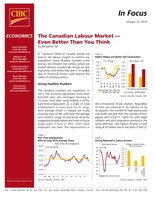Wages up, youth employment rising, older Canadians working less
TORONTO, Jan. 10, 2018 /CNW/ - Canada's job market is even better than the recent headlines suggest, indicating that the Bank of Canada should not look to the labour market to confirm any trepidation, finds a new report from CIBC Capital Markets.
"Good headline numbers come and go, but beneath the surface, where job market demons usually hide, things are also improving," says Benjamin Tal, Deputy Chief Economist, CIBC. "And, where they aren't, it's largely due to structural forces – well beyond the realm of monetary policy."
His report, "The Canadian Labour Market – Even Better Than You Think", examines the three key vulnerabilities in the job market that could jeopardize the current expansion and durability of the recent improvement in wage inflation – youth unemployment, the duration of unemployment, and the impact of the 55+ age demographic – and finds that there's less slack in the labour market than policymakers perceive.
Better wages, better job quality:
Beyond the impressive creation of more than 420,000 jobs in 2017, the Canadian job market has seen average wage earnings grow and the creation of more higher-paying jobs last year than low-paying ones.
"Real labour income is now rising at its fastest rate in five years," says Mr. Tal.
Youth employment on the rise:
Although youth unemployment has been a source of concern for a while, that isn't the case anymore.
Mr. Tal points out that the youth unemployment rate has been falling faster than the unemployment rate among adults. Today, the youth-to-adult jobless rate is just over 2 per cent, below its long-term average.
What's more, the real youth unemployment rate is much lower than suggested by the headline numbers when excluding youth aged 15-18 enrolled in high school who should not be classified as unemployed as their main activity is learning.
"If it was not for the 'unemployed' high-school students, the Canadian unemployment rate in December 2017 would have been 5.2 per cent as opposed to the headline number of 5.7 per cent," said Mr. Tal. "The fact that more high-school students decide to focus more on school and less on part-time employment is not a factor that shows real labour market slack. It shows that people are busy preparing for the labour market of tomorrow."
The Bank of Canada has also expressed concern over the youth labour-force participation rate, which has fallen nearly five percentage points over the past decade.
Mr. Tal points out that nearly all of that decline is due to lower participation among high-school students.
"The fact that an increased number of high-school students decide to focus on school and less on part-time employment is not a macro factor indicating real labour slack," he says.
Out of work for longer periods:
The jobless rate encompasses both the number of unemployed people who have recently become unemployed and the number of those who have been unemployed for a period of time.
The rate at which people become unemployed is currently at a record low. But, people are staying unemployed longer – and the issue is that the Bank of Canada can generally only influence the former, not the latter through monetary policy.
"The increase in long-term unemployment is largely due to a mismatch in the labour market – way beyond the domain of monetary policy," says Mr. Tal.
The 55+ factor:
For those who have been in the Canadian labour force for a while, Mr. Tal notes that wage inflation and absolute wage levels are not materially different from that seen among prime-age workers.
Workers aged 55+ represent the fastest-growing segment of the labour market, he says.
But, they are also slowly disengaging from the labour force by working fewer hours each year.
Mr. Tal estimates that in 2017, the 55+ factor reduced the total number of hours worked by no less than 2 per cent, by far the largest impact on record. This will only increase in time.
This reduction in the average hours worked is often taken as a sign of labour market slack, suggesting that the labour market isn't as strong as perceived. But, this is a demographically-induced trend that the Bank of Canada cannot do anything to reverse, Mr. Tal points out.
The report notes that Canada's labour market will be tested in 2018 by challenges, such as minimum wage hikes and headwinds from ongoing NAFTA negotiations. The ultimate impact of those forces is unknown.
"What we do know is that the labour market is well positioned to face what's coming," he says.
About CIBC
CIBC is a leading Canadian-based global financial institution with 11 million personal banking, business, public sector and institutional clients. Across Personal and Small Business Banking, Commercial Banking and Wealth Management, and Capital Markets businesses, CIBC offers a full range of advice, solutions and services through its leading digital banking network, and locations across Canada, in the United States and around the world. CIBC Capital Markets provides integrated global markets products and services, investment banking advisory and execution, corporate banking and top-ranked research to corporate, government and institutional clients around the world. Visit www.cibccm.com for more information on CIBC and CIBC Capital Markets. Ongoing news releases and more information about CIBC can be found at www.cibc.com/en/about-cibc/media-centre.html.
SOURCE CIBC - Economic Research

Benjamin Tal, Deputy Chief Economist, CIBC Capital Markets, 416-956-3698, [email protected], or Jason Wesley, Communications and Public Affairs, at 416-408-9507, or [email protected].


Share this article